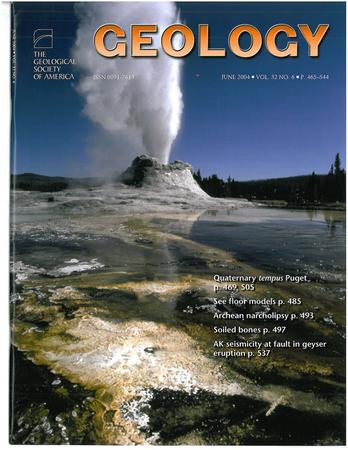From plant roots to mountain roots: Impact of land plants on arc magmatism
IF 4.6
1区 地球科学
Q1 GEOLOGY
引用次数: 0
Abstract
The hypothesis that the evolution of land plants influenced arc magmatism offers a compelling link between Earth’s biological evolution and plate tectonics. Land plants transformed terrestrial environments, increasing fluvial sediment residence times, intensifying chemical weathering, and increasing clay production. Incorporating muddier alluvial protolith into magmas resulted in a systematic increase in the strength of correlation between δ18O, which reflects the degree of surface weathering, and εHf, which indicates the age of the source material. The emergence of this εHf/δ18O correlation at ca. 450 Ma coincides with the expansion of land plants across a broad latitudinal range, from low to high latitudes. However, the extent to which this isotopic signal represents a global phenomenon, rather than a bias introduced by uneven geographic sampling of detrital zircon, has been questioned. We demonstrate that this shift in correlation persists within single long-lived magmatic provinces, supporting the hypothesis that the isotopic shift reflects a fundamental irreversible change in sediments assimilated into magmatic systems. This isotopic shift occurs in arc systems at various paleolatitudes, indicating no detectable dependence on latitudinally controlled climatic or biologic processes. Therefore, the post−450 Ma shift in arc magma composition remains a key indicator of changing Earth surface processes during the mid-Paleozoic.从植物根到山根:陆生植物对弧岩浆作用的影响
陆生植物的演化影响了弧岩浆作用的假说为地球的生物演化和板块构造之间提供了令人信服的联系。陆地植物改变了陆地环境,增加了河流沉积物的停留时间,加剧了化学风化,增加了粘土的产生。岩浆中加入泥质冲积原岩后,反映地表风化程度的δ18O与反映源物质年龄的εHf之间的对比强度系统增强。这种εHf/δ18O相关性在约450 Ma的出现与陆地植物在从低纬度到高纬度的广泛纬度范围内的扩张相吻合。然而,这种同位素信号在多大程度上代表了一种全球现象,而不是碎屑锆石的不均匀地理采样所带来的偏差,这一点受到了质疑。我们证明,这种对比变化在单个长寿命的岩浆省中持续存在,支持了同位素变化反映了被岩浆系统同化的沉积物的根本不可逆变化的假设。这种同位素变化发生在不同古纬度的弧系统中,表明对纬度控制的气候或生物过程没有明显的依赖。因此,- 450 Ma后弧岩浆组成的变化仍然是中古生代地球表面过程变化的关键指标。
本文章由计算机程序翻译,如有差异,请以英文原文为准。
求助全文
约1分钟内获得全文
求助全文
来源期刊

Geology
地学-地质学
CiteScore
10.00
自引率
3.40%
发文量
228
审稿时长
6.2 months
期刊介绍:
Published since 1973, Geology features rapid publication of about 23 refereed short (four-page) papers each month. Articles cover all earth-science disciplines and include new investigations and provocative topics. Professional geologists and university-level students in the earth sciences use this widely read journal to keep up with scientific research trends. The online forum section facilitates author-reader dialog. Includes color and occasional large-format illustrations on oversized loose inserts.
 求助内容:
求助内容: 应助结果提醒方式:
应助结果提醒方式:


